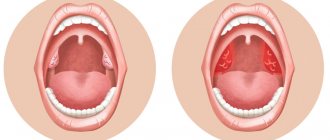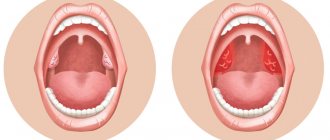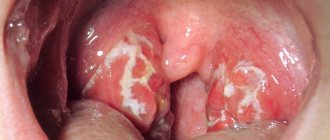The article was prepared by a specialist for informational purposes only. We urge you not to self-medicate. When the first symptoms appear, consult a doctor.
The tonsils are classified as organs of the human immune system; they meet and trap microorganisms inhaled with air, so they often become inflamed.
Most often, the pathological process in the tonsils is acute. The disease begins with a sharp pain in the throat when swallowing, general weakness, and increased body temperature. Some patients complain of aches, chills, and headaches. The submandibular lymph nodes in patients are usually enlarged and painful on palpation.
The inflammatory process should not be ignored, as this leads to serious complications. The disease can become chronic, which takes a long time and is difficult to treat.
The causes of inflammation of the tonsils are now quite well studied. The disease responds well to therapy and with timely treatment does not threaten serious complications. Inadequate treatment or late consultation with a doctor can cause serious consequences. Today it has already been proven that rheumatic carditis, myocarditis, and pyelonephritis develop against the background of sore throat.
Tonsils - what are they and why are they needed?
The tonsils are represented by lymphoid tissue, which provides human protection, that is, it belongs to the organs of the immune system. The tonsils prevent harmful flora from entering the respiratory tract.
Lymphoid tissue contains lymphocytes. These cells actively fight microbes, viruses and fungi, preventing them from multiplying. The tissue of the tonsils is loose, so representatives of pathogenic flora are retained in it. If protection is provided at the proper level, then they will simply be destroyed by lymphocytes.
The tonsils (or palatine tonsils, which are located between the palatine arches) are a collection of lymphoid tissue that is designed to protect the respiratory system. The tubal tonsils are paired and are located in the pharynx. If you just look into your mouth, you won't be able to see them. They are rarely subject to inflammation.
Single tonsils include the pharyngeal and lingual tonsils. The pharyngeal tonsil is located at the arch of the pharyngeal wall. It is called adenoids, and when it becomes inflamed, it indicates adenoiditis. It most often affects young children. In adults it undergoes reverse development. The lingual tonsil is located under the tongue at the back of it. It gets inflamed less often than others.
Causes of inflammation of the tonsils
Inflammation of the tonsils most often results from infections caused by viral or bacterial flora.
Its representatives reach the tonsils through the nose and mouth, since most of them are transmitted by airborne droplets. They linger on the mucous membrane and provoke its inflammation.
Infectious agents that most often lead to disease:
- Staphylococci.
- Streptococci.
- Adenoviruses.
- Herpes virus.
- Haemophilus influenzae.
- Mycoplasmas.
People encounter pathogens every day. However, people don't get sick that often.
The infection develops when the body is simultaneously affected by several factors:
- Hypothermia.
- Weakened immunity due to a previous illness.
- Acute stage of chronic disease.
- Unbalanced diet, vitamin deficiency.
- Injury to the mucous membranes of the oral cavity.
- Emotional shock.
The final diagnosis will differ depending on the location of the inflammatory process:
- Acute sore throat. Inflammation is concentrated in the tonsils, the degree of its intensity varies. Catarrhal tonsillitis is characterized by swelling of the mucous membranes, an increase in body temperature up to 38 °C, and mild pain. With follicular angina, all symptoms intensify. If you examine the surface of the tonsils, you can see a white coating on them. The third type of sore throat is lacunar inflammation. In this case, purulent masses accumulate in the folds of the tonsils. This leads not only to severe pain, but also to the appearance of bad breath.
- Chronic sore throat. This form of the disease develops in people who have not received adequate therapy for acute inflammation. From time to time, a sore throat will remind itself. If you examine the tonsils of a person with chronic tonsillitis, you can see white plugs on them, which are concentrated in the lacunae. At the same time, a person may not complain about a sore throat.
- Adenoiditis. With this disease, the inflammatory process will be concentrated in the pharyngeal tonsil. A person’s nasal breathing worsens, discomfort appears in the throat, and the mucous membranes swell. The disease tends to become chronic.
Why do tonsils become inflamed?
The tonsils themselves are not smooth, as they may seem externally. They have a porous structure and consist of winding channels (crypts) and depressions (lacunae). This is where the pathogenic microorganisms that the tonsils fight come from. In a healthy state, tonsils can cleanse themselves, removing dead bacteria and leukocytes from their thickness. But if a person’s immunity is weak, frequent inflammations lose their self-cleansing function - all this accumulates in the tonsil, forming purulent plugs.
Some patients mistake these white plugs on the surface of the tonsils for food debris, and do not receive quality treatment for the tonsils. But this is nothing more than a compressed infection that continues to maintain inflammation. That is why the patient has a sore throat during an exacerbation, the temperature rises, and bad breath appears due to traffic jams. Treatment of tonsils should be carried out efficiently and under the supervision of an otolaryngologist!
Inflammation of the tonsils is called acute tonsillitis, or tonsillitis. Prolonged inflammation, alternating with stages of exacerbation and remission, is called chronic tonsillitis.
Streptococci, staphylococci, pneumococci, anaerobic bacteria, and fungi can provoke an inflammatory process in the tonsils. In order to diagnose and begin to treat the disease in a timely manner, you need to be able to recognize the symptoms (and treatment should be carried out by a competent ENT doctor).
Symptoms of inflammation of the tonsils
Symptoms characterizing the inflammatory process in the tonsils may vary, although slightly.
Common signs of the disease include:
- Increase in body temperature to high levels.
- Swelling of the mucous membrane of the oropharynx, hyperemia of the mucous membranes.
- Cough.
- Runny nose. With angina, this symptom is most often absent.
- General physical weakness.
If a person is infected with herpetic sore throat, then in addition to a sore throat and high body temperature, he experiences discomfort in the abdomen, and a small rash that looks like blisters is noticeable on the tonsils and back wall of the throat. They contain liquid. In the future, it can become purulent. After opening the blisters, the affected areas become covered with crusts.
If a person has an inflamed lingual tonsil, this is manifested by the following symptoms:
- The tongue swells and it hurts for a person to move it.
- When chewing and swallowing food, severe discomfort occurs.
- Pain forces a person to change his speech, as intense movements of the tongue become impossible.
Sometimes the patient notices that his tonsils are inflamed, but does not experience pain. This symptom may indicate chronic tonsillitis.
The temperature remains within normal limits, as the immune system stops making efforts to fight the source of infection.
Inflammation of the tonsils
More often than other tonsils, it is the tonsils that suffer in people. The most common pathology is acute or chronic tonsillitis. This disease becomes dangerous for humans if there is no treatment. The therapy must be selected by a doctor; this is the only way to make it effective.
The success of treatment is determined by its focus. To do this, you need to know which microorganism caused the inflammatory reaction. For this purpose, the doctor prescribes a bacteriological examination of a throat smear. When the analysis is ready, the doctor will be able to select the optimal therapy.
Unilateral inflammation of the tonsil
If the infection affects the tonsil on one side, this indicates activation of local immunity. He dealt with the pathogenic flora on one of the tonsils on his own and is able to maintain its health.
Sometimes unilateral inflammation is a sign of facial neuritis, lymphadenitis or other disorders that are not associated with otolaryngological diseases.
Unilateral inflammation requires treatment, which is selected in accordance with the causes of the disease.
Inflamed tonsils in a child
In children, the tonsils become inflamed very often. The causes in most cases come down to a viral infection or a sore throat.
If cold viruses have entered a child’s body, then most often his condition is not significantly affected. After 3 days there is a significant improvement that can be compared to recovery.
When a child has a sore throat, the symptoms will be as follows:
- Increase in body temperature to high levels.
- The appearance of a severe sore throat, which makes the child refuse not only food, but also water.
- Children become whiny and lose their usual activity.
- Breathing becomes heavier.
- A white coating appears on the tonsils.
If you can cope with a common cold on your own, then a sore throat requires medical help. Most often, this disease is treated with antibiotics.
Inflammation of the adenoids is no less common a problem than tonsillitis. With adenoiditis, the pharyngeal tonsil increases in size.
Symptoms that will indicate an inflammatory reaction:
- Snore.
- The appearance of mucus from the nose, which will have a green or yellow color.
- Headache.
- Deterioration in sleep quality.
- Cough.
- Voice change. He becomes nasal.
To cope with adenoiditis and prevent further growth of tonsil tissue, you need to consult a doctor.
Acute tonsillitis: treatment
Treatment of acute tonsillitis lasts seven to ten days and takes place at home according to the therapy prescribed by the otolaryngologist.
The patient needs strict bed rest and dietary adjustments. Since the throat hurts unbearably during a sore throat, food should not injure the throat: it should not be very hot or cold, too spicy or hard. It is ideal to eat pureed foods, and do not forget to drink plenty of fluids.
In the patient's room, it is necessary to maintain conditions conducive to rapid recovery: ventilate the room more often and carry out wet cleaning.
You also need to remember that sore throat can easily be contracted through the patient’s personal items, so if someone in the family has a sore throat, you should not share the same dishes, towels, etc. with the patient.
Drug therapy includes taking antibiotics. An antibacterial drug can only be prescribed by an ENT doctor. It is necessary to take the full course of the medicine, even if it has become easier and it seems that your throat no longer hurts. Incomplete treatment can cause chronic inflammation and other complications.
The temperature with a sore throat needs to be brought down with antipyretic drugs. When your throat hurts due to a sore throat, you should stock up on anti-inflammatory sprays, antiseptic gargles, lozenges and lozenges with an anesthetic effect. If you follow all the instructions of the ENT doctor, the sore throat goes away quickly enough and recovery occurs.
Which doctor should you consult if you have inflammation of the tonsils?
The diagnosis and treatment of diseases of the tonsils is carried out by an ENT doctor, that is, an otolaryngologist. You should contact a specialist when the first symptoms of inflammation appear. However, few people rush to consult a doctor if their throat starts to hurt a little. It is possible that you will be able to cope with the disease on your own.
However, there are some conditions that require immediate medical attention:
- Body temperature reaches 38 °C and above. It lasts longer than 3 days.
- The person’s well-being deteriorates sharply.
- First there is an improvement, and then a deterioration in the condition.
- The child's tonsils become inflamed.
- Purulent foci of infection are visible in the throat.
Treatment of sore tonsils in adults
Most often, inflammation can be dealt with at home. However, if the lingual tonsil is affected, hospitalization is always required.
Self-therapy can only be carried out if a person is firmly convinced that the inflammation has a viral basis. A bacterial infection requires contacting a doctor, as it poses a danger to the patient’s health. Treatment boils down to taking medications that are aimed at eliminating the causative agent of inflammation. In addition, efforts need to be directed towards making a person feel better. This treatment is called symptomatic.
If a person decides to cope with inflammation on his own, but after 3 days there is no improvement, then he should consult a doctor.
Recommendations to speed up recovery:
- You need to drink as much fluid as possible. In addition to water, it is good to drink tea, compotes, broths, and fruit drinks.
- During the acute phase of the disease, a person must adhere to bed rest.
- There is no need to force yourself to eat. Food is consumed as appetite appears.
If the disease is complicated by suppuration, which cannot be relieved at home, the person is recommended to wash the tonsils in the ENT office.
Removal of tonsils is rarely done. Surgery is required only when all conservative methods have proven ineffective. Patients with chronic tonsillitis and adenoiditis may also need the help of a surgeon.
Medication correction
If the inflammation of the tonsils is of a viral nature, then it will be possible to limit oneself to symptomatic therapy; it is recommended to take antiviral drugs that have a local immunomodulatory effect. The body must cope with the infection on its own. You just need to help him a little.
For this purpose, drugs such as:
- Sore throat sprays and cough drops. Effective drugs are: Strepsils, Septolete, Ingalipt, Chlorophyllipt, Givalex, Tantum Verde, Lizak, Lizobakt, Faringosept, Throat spasm, etc. These drugs have not only an analgesic, but also an antiseptic effect.
- Gargles: Angilex, Chlorophyllipt, Furacilin, Streptocide, Rotocan, Givalex, etc. The more often a person performs this procedure, the faster the recovery will occur. Gargling allows you to remove not only viral flora from the tonsils, but also pus, as well as dead tissue.
- Drugs to reduce body temperature: Panadol, Nurofen, Nimesil, Efferalgan, Nise, etc.
If the inflammation was caused by microbial flora, then it can only be dealt with using antibiotics for a sore throat. Taking them helps prevent the development of complications. The drug must be recommended by a doctor. The dose is selected depending on the severity of the infection. For local therapy, agents with an antibacterial component are used, such as: Polydexa, Isofra, Rinil. If they do not achieve the desired effect, then the patient is advised to take systemic antibacterial drugs. These may be drugs such as: Augmentin, Flemoxin, Amoxiclav, Amoxicillin, Vilprafen, etc.
In order to avoid relapses, antibacterial drugs are taken in full course. The patient needs to complete treatment, even if he feels better after a couple of days of taking medications.
If more than 3 days have passed since the start of antibacterial therapy and there is no effect, then it is necessary to change the drug. This means that the pathogenic flora has resistance to it. In the future, tetracyclines (Tetracycline, Doxycycline, Unidox Solutab, etc.) or macrolides (Sumamed, Hemomycin, Azithromycin) can be used.
Taking a smear from the throat allows you to identify the representative of the pathogenic flora that caused the inflammation and determine which drugs it responds to. However, the results of the LHC culture will be known no earlier than in 5-7 days. Delaying treatment for such a long period of time can be dangerous. Bacterial inflammation, as well as a viral infection, requires symptomatic therapy with mandatory gargling.
Treatment of inflamed tonsils in children
Treatment of inflamed tonsils in children should be pathognomic, that is, aimed at eliminating the cause of the disease.
- If a child has an acute respiratory viral infection, then he needs to treat his throat, lower his body temperature, and give painkillers.
- A bacterial infection requires consultation with a pediatrician. The doctor must select the antibiotic.
- Adenoiditis takes longer to cure than other diseases. To carry out therapy, they resort to corticosteroid drugs (Flicosnase, Nasonex). Vasoconstrictor nasal drops (Nazivin, Xylometazoline, Rinazoline) are also used. To combat pathogenic flora, agents such as Protargol, Collargol, etc. can be used.
For the disease to lead to serious complications, parents should consult a doctor in the following situations:
- Body temperature remains high, even after taking antipyretic medications.
- White plugs or white plaque are visible on the tonsils.
- The child coughs a lot.
- Nasal discharge is yellow-green in color.
Treatment.
An effective treatment tactic will be chosen by an ENT doctor only after the cause of tonsil hypertrophy has been established.
Depending on the cause of inflammation, the patient is prescribed:
- antibacterial drugs if the causative agent of the disease is bacteria. Moreover, the medicine must be taken “from start to finish” - a strictly defined number of days, even if the child feels better. Continuous treatment is the key to a quick recovery without complications;
- antiviral drugs, if the causative agent of the disease is a viral infection;
- antifungal agents, if the cause of inflammation is fungi;
- gargling and irrigating the throat with antiseptics - constantly gargling is necessary to wash away pathogenic flora from the mucous membranes;
- antihistamines to relieve tissue swelling, and if the cause of throat discomfort is an allergic reaction;
- washing the lacunae of the palatine tonsils from pathogenic flora (it is optimal to start washing from 6-7 years of age);
- physiotherapeutic procedures (laser, ultrasound, photodynamic therapy, ultraviolet exposure, etc.)
Some parents believe that it is easier to remove the tonsils and get rid of the problems associated with them. But this is not a solution! Removal requires strict indications: more than four sore throats during the year, bad rheumatic tests, peritonsillar abscess and complications in the heart, kidneys and joints. If there are no indications, you need to be observed by an ENT doctor and, if necessary, carry out timely treatment.










